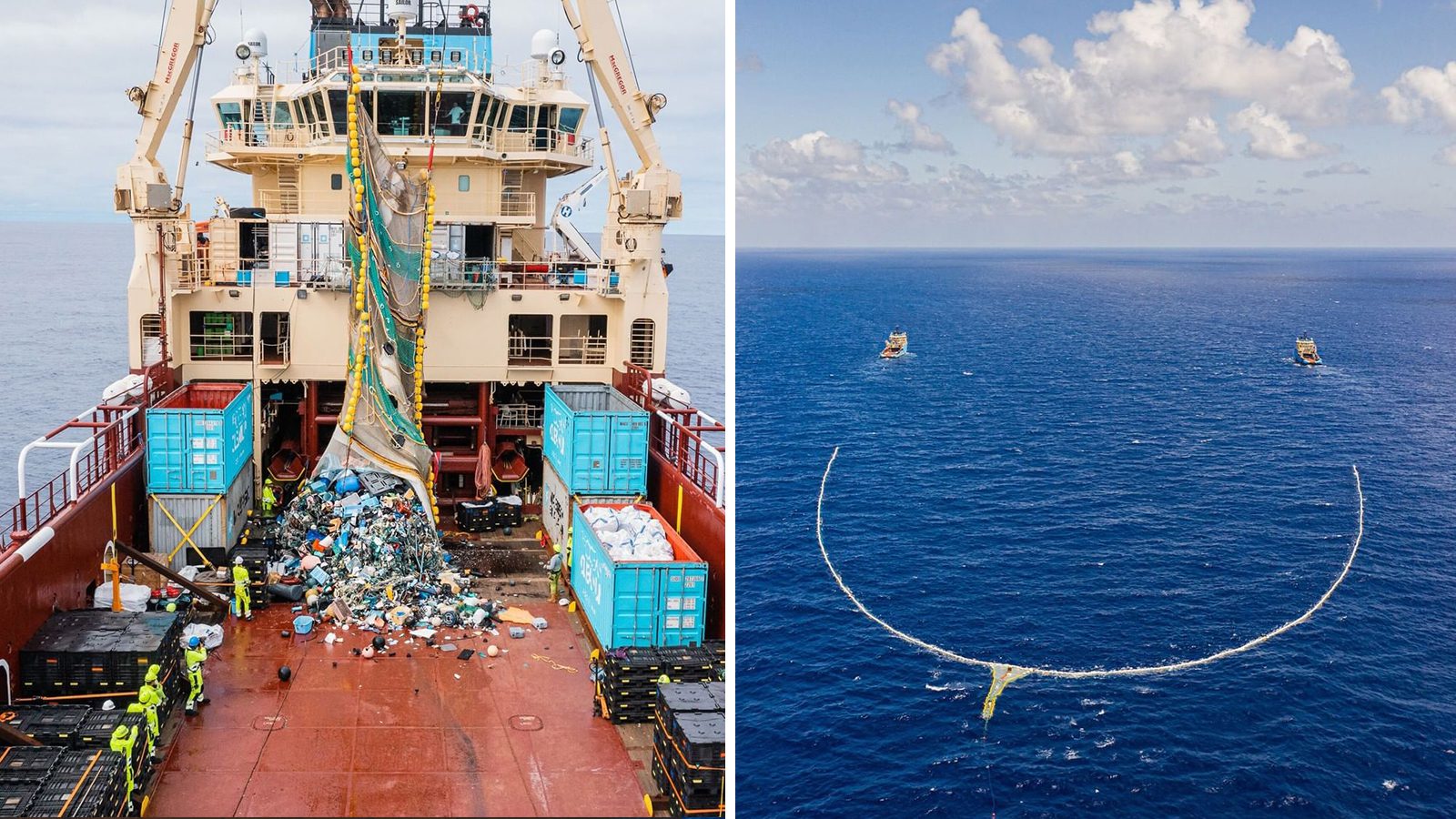A nonprofit organization called The Ocean Cleanup recently collected 20,000 tons of plastic from the Pacific Ocean. The massive cleanup operation marked a considerable step toward completely ridding the oceans of plastic.
The environmental company based in the Netherlands creates technology to remove plastic pollution from oceans and rivers. 27-year-old Boyan Slat founded the company nearly a decade ago, in 2013. At just 18 years old, he knew his purpose in life: making the oceans more habitable for marine life. To do that, he wanted to develop technology to extract the trillions of plastic items from these delicate ecosystems.
He hopes to remove 90% of ocean surface plastic by 2040. It’s an ambitious goal, but some scientists remain skeptical about the organization’s execution. In 2018, the Ocean Cleanup launched its first plastic-catching device, but ocean currents caused it to break.
A follow-up model released in 2019 performed better than the first model. However, the company said it would probably require hundreds of those devices to reach its goal. Scientists and engineers wondered if the organization could deliver its promises backed by millions in funding.
This past summer, The Ocean Cleanup revealed its latest model, nicknamed Jenny. They believe this new device will make a massive dent in the plastic pollution clogging the oceans. The device acts as an artificial floating coastline with a plastic-trapping mechanism resembling a giant arm. Once the plastic gets caught in this fold, it makes its way into a large net shaped like a funnel.
Then, two ships tow the net through the water at a speed of roughly 1.5 knots. You could probably walk faster than that, but the slow speed ensures the net doesn’t break in rough waters. Ocean currents push any floating plastic toward the device, making it easy to trap the wayward garbage.
Pacific Ocean Clean-Up Yields Over 20,000 Tons of Waste
 The team launched Jenny in the Great Pacific Garbage Patch in August 2021. This ocean area contains the most extensive collection of plastic garbage in the world. Located between Hawaii and California, over 1.8 trillion pieces of plastic swirl continuously in this enormous vortex.
The team launched Jenny in the Great Pacific Garbage Patch in August 2021. This ocean area contains the most extensive collection of plastic garbage in the world. Located between Hawaii and California, over 1.8 trillion pieces of plastic swirl continuously in this enormous vortex.
According to a 2018 study in Scientific Reports, the vortex “covers an estimated surface area of 1.6 million square kilometers, an area twice the size of Texas or three times the size of France.”
At the time of sampling, the team estimated that over 1.8 trillion pieces of plastic had accumulated in the Pacific Ocean. It’s believed that the plastic weighed about 80,000 tons, 4-16 times higher than prior calculations. To put the sheer enormity in perspective, that’s the equivalent weight of 500 Jumbo Jets.
So, it’s of paramount importance to clean up this floating wasteland in the Pacific Ocean. The team couldn’t think of a better place to test their latest device than the Great Pacific Garbage Patch. They wanted to see if Jenny could carry large volumes of plastic to shore without any disruptions.
Luckily, Jenny performed even better than they expected. She hauled 9,000 kilograms, or 20,000 pounds, of plastic trash out of the Pacific Ocean. This overwhelming success proves that waste cleanup efforts with more of these devices would pay off.
How the New Technology Removes Plastics from Oceans
Slat’s first ocean-cleaning prototype, a 330-foot-long floating boom, resembled a long pipe in the ocean. While this first model failed, he’s significantly progressed in developing a functional, effective device. The latest U-shaped funnel version allows for more flexibility and can’t break as easily.
The net attached to the device gets filled with plastic every few weeks. Then, the crew pulls the net out of the water, removing the plastic onto two ships. Once they bring it to shore, the team sorts the plastic, recycles it, and creates sunglasses from the waste. 100% of the proceeds from the sunglasses go toward continuing cleanup efforts. The company hopes to collaborate with popular brands to create other recycled products in the future.
To clean 50% of the Great Pacific Garbage Patch in five years, Slat estimated it would require about 10 Jennys. He said that one of these devices could haul 10,000 to 15,000 kilograms of plastic from the Pacific Ocean.
Experts Still Concerned about the Devices
Scientists and engineers have voiced concerns about plastic-cleaning devices despite the recent successful cleanup. The Ocean Cleanup technologies capture a variety of floating garbage, from fishing nets to laundry baskets to microplastics. However, the machines only collect plastic floating near the ocean’s surface. Experts estimate that the ocean floor may have thirty times as much plastic as the surface.
The organization says the large plastic pieces on the surface will eventually break into microplastics. Even though they can’t access the plastic near the bottom, they argue it’s still better than doing nothing.
Of course, the best way to prevent plastic from entering the oceans is to stop producing and consuming it. Experts estimate that nearly 11 million metric tons of plastic enter the oceans annually. By 2040, they believe this number may almost triple to 29 million metric tons. According to the Ocean Cleanup, ten Jenny devices can collect about 15,000-20,000 metric tons annually.
That would barely make a dent in the plastic choking the oceans. The boats that pull the device use fuel, putting further strain on the environment. The original device passively collected plastic using the movement of ocean currents. However, the newly clean water quickly became polluted again since trash leaked into the ocean with this design.
The organization said they purchased carbon credits to offset the environmental cost of the boats’ emissions.
This project is a massive undertaking requiring support from the public and business interests. While some kinks need ironing out, Slat believes a small fleet of these systems would go a long way in cleaning the oceans.
 Final Thoughts: A new device eliminates 20,000 tons of plastic waste from the Pacific Ocean
Final Thoughts: A new device eliminates 20,000 tons of plastic waste from the Pacific Ocean
Without healthy oceans, we can’t survive on this planet. Knowing the dire situation, the Ocean Cleanup vows to eliminate 90% of floating ocean plastic by 2040. While the devices still need some fine-tuning and scaling, they’ve already shown great promise in cleaning the Pacific Ocean. Hopefully, we will one day have an utterly plastic-free world where all life can thrive.




















